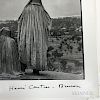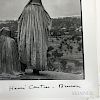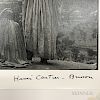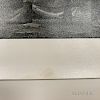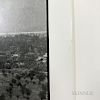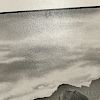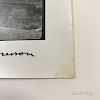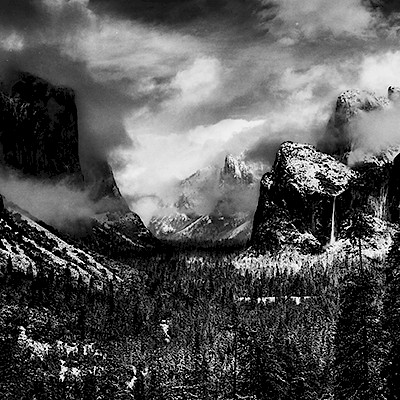Henri Cartier-Bresson (French, 1908-2004) Srinagar, Kashmir
Lot 103
About Seller
Bonhams Skinner
274 Cedar Hill Street
Marlborough, MA 01752
United States
Founded over four decades ago, Bonhams Skinner offers more than 60 auctions annually. Bonhams Skinner auctions reach an international audience and showcase the unique, rare, and beautiful in dozens of categories, including the fine and decorative arts, jewelry, modern design, musical instruments, sc...Read more
Categories
Estimate:
$12,000 - $18,000
Absentee vs Live bid
Two ways to bid:
- Leave a max absentee bid and the platform will bid on your behalf up to your maximum bid during the live auction.
- Bid live during the auction and your bids will be submitted real-time to the auctioneer.
Bid Increments
| Price | Bid Increment |
|---|---|
| $0 | $10 |
| $100 | $25 |
| $500 | $50 |
| $1,000 | $100 |
| $3,000 | $250 |
| $5,000 | $500 |
| $10,000 | $1,000 |
| $30,000 | $2,500 |
| $50,000 | $5,000 |
| $100,000 | $10,000 |
| $300,000 | $25,000 |
| $500,000 | $50,000 |
| $1,000,000 | $100,000 |
About Auction
By Bonhams Skinner
Jan 23, 2020
Set Reminder
2020-01-23 18:00:00
2020-01-23 18:00:00
America/New_York
Bidsquare
Bidsquare : Fine Prints, Multiples & Photographs
https://www.bidsquare.com/auctions/skinner/fine-prints-multiples-photographs-4793
the Fine Prints & Multiples auction features Western fine art prints and multiples from the old masters to the present day and the Fine Photographs auction offers a broad range from the 19th century to the present day featuring classic works by modern masters. Bonhams Skinner bidsquare@bonhamsskinner.com
the Fine Prints & Multiples auction features Western fine art prints and multiples from the old masters to the present day and the Fine Photographs auction offers a broad range from the 19th century to the present day featuring classic works by modern masters. Bonhams Skinner bidsquare@bonhamsskinner.com
- Lot Description
Henri Cartier-Bresson (French, 1908-2004)
Srinagar, Kashmir, 1948, a later printing. Signed "Henri Cartier-Bresson" in ink l.r., inscribed "41 AGP" in pencil l.l. on the verso and "Z. 201" in pencil l.r. Gelatin silver print, image size 9 1/2 x 14 in. (24.1 x 35.6 cm), framed.
Condition: Small area of staining affecting the emulsion to l.c. edge and l.r. corner outside of the image, minor accretions to u.l. edge visible in raking light.
N.B. Cartier-Bresson visited India for the first time in 1947 amid its fraught postwar political transition from British colonial rule to independence and the partition of India and Pakistan. This period was marked by a surge of violence between Hindus, Muslims, and Sikhs, with the partition displacing hundreds of thousands of refugees between India and Pakistan in just two years, and several millions in the decades after. From 1931-1951 several million refugees went missing as they attempted to cross into either India or Pakistan in order to escape religious attacks and persecution, and up to 2 million people perished due to wide-spread violence. Arguably one of the most notable victims of this religious violence was Mahatma Gandhi. In 1948, Cartier-Bresson met with Gandhi, who had just finished a six-day fast calling for an end to the inter-communal brutality over the partition. They met again the following day a mere 90 minutes before Gandhi was assassinated by a Hindu Nationalist. Cartier-Bresson subsequently documented his funeral and the national outpouring of grief that followed in the wake of his death.
His images from this three-year trip to Asia are often quiet and self-effacing, such as Srinagar, Kashmir, where a group of Muslim women gather on top of Hari Parbat hill to pray as the sun rises behind the Himalayas. The image is full of a static gravity while bearing Cartier-Bresson's characteristic strength in structure as seen in the visual parallel between the line of the women and the mountains. Aware of his privileged position as a white European male, he made an effort not to photograph India from above in what could be seen as a reductive manner, but instead placed himself among his subjects. His portfolio of India captured scenes of mourning and fleeing refugees, but also scenes of daily life and its rituals. With these images Cartier-Bresson achieved global recognition as both an artist and photojournalist, and would go on to document his travel around the world.
Estimate $12,000-18,000
Sheet size 12 x 15 3/4 in. The print suggests the negative has been retouched.
Items may have wear and tear, imperfections, or the effects of aging. Any condition statement given, as a courtesy to a client, is only an opinion and should not be treated as a statement of fact. Skinner shall have no responsibility for any error or omission. - Shipping Info
-
Please visit http://www.skinnerinc.com/services/payment-and-shipping/ for information regarding the collection of items purchased at auction.
-
- Buyer's Premium



 EUR
EUR CAD
CAD AUD
AUD GBP
GBP MXN
MXN HKD
HKD CNY
CNY MYR
MYR SEK
SEK SGD
SGD CHF
CHF THB
THB


